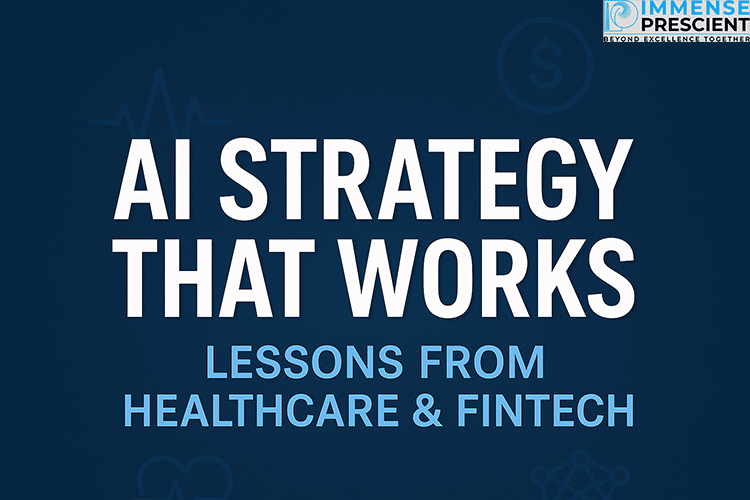What a Good AI Strategy Looks Like?
Introduction – AI strategy lessons from healthcare and fintech
Artificial Intelligence (AI) has moved beyond hype it’s now an operational necessity. But not every organization that invests in AI achieves measurable outcomes. The difference lies in having a clear AI strategy that balances vision with execution.
In this blog, we’ll share practical lessons from healthcare and fintech projects that highlight what a good AI strategy looks like, and how other industries can replicate these best practices.
Lesson 1: Start with Real Business Problems, Not Technology
In healthcare, one of the most successful AI deployments wasn’t about cutting-edge algorithms it was about solving a clear bottleneck: reducing patient wait times for diagnostic results. By focusing AI on optimizing workflows rather than replacing doctors, hospitals achieved measurable efficiency gains.
In fintech, AI proved transformative in fraud detection not because the models were flashy, but because the strategy directly addressed financial losses that had a bottom-line impact.
Takeaway: A good AI strategy starts with defining where AI can deliver tangible value, not where it looks impressive.
Lesson 2: Data Quality > Data Quantity
Both industries show that AI models are only as good as the data they’re trained on. Healthcare projects often failed when relying on fragmented patient records, while fintech firms succeeded by prioritizing clean, structured transaction data before scaling models.
Takeaway: Invest in data governance, interoperability, and cleaning pipelines. AI maturity is a data discipline, not just a tech one.
Lesson 3: Build Cross-Functional Teams
In healthcare, clinicians worked hand-in-hand with data scientists to ensure AI tools were clinically relevant and ethically sound. In fintech, compliance officers sat at the table alongside machine learning engineers to keep innovations aligned with regulation.
Takeaway: AI is not a siloed IT initiative. It requires collaboration between business, compliance, data, and technical stakeholders.
Lesson 4: Pilot, Learn, Then Scale
Both healthcare and fintech projects succeeded when they piloted AI in controlled environments, measured outcomes, and then scaled. Hospitals tested AI on limited patient groups before rolling out system-wide. Fintech startups launched fraud detection AI in specific product lines before expanding.
Takeaway: A successful AI strategy prioritizes measured pilots over reckless scaling.
Lesson 5: Governance and Ethics are Non-Negotiable
Healthcare AI strategies that succeeded had clear ethical guidelines patients trusted systems because hospitals explained how AI supported (not replaced) clinicians. In fintech, ethical AI practices helped avoid bias in credit scoring and ensured compliance with regulators.
Takeaway: Governance frameworks are the backbone of a resilient AI strategy.
Conclusion: What a “Good” AI Strategy Looks Like
From hospitals to banks, the most successful AI strategies are not about flashy algorithms but about alignment with business needs, clean data, cross-functional collaboration, pilot-first approaches, and strong governance.
Whether you’re in retail, manufacturing, or logistics, these lessons from healthcare and fintech can guide your path to a scalable, ethical, and impactful AI future.




